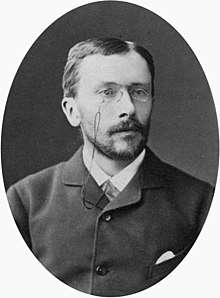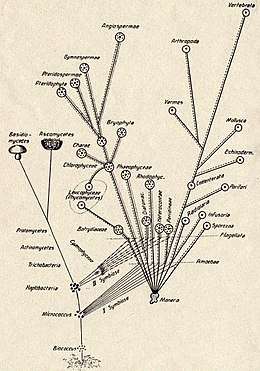Konstantin Mereschkowski
Konstantin Sergeevich Mereschkowski[lower-alpha 1] (Russian: Константи́н Серге́евич Мережко́вский, IPA: [mʲɪrʲɪˈʂkofskʲɪj]; 4 August 1855 [O.S. 23 July] – 9 January 1921) was a prominent Russian biologist and botanist, active mainly around Kazan, whose research on lichens led him to propose the theory of symbiogenesis – that larger, more complex cells (of eukaryotes) evolved from the symbiotic relationship between less complex ones. He presented this theory in 1910, in his Russian work, The Theory of Two Plasms as the Basis of Symbiogenesis, a New Study of the Origins of Organisms,[2] although the fundamentals of the idea already had appeared in his earlier 1905 work, The nature and origins of chromatophores in the plant kingdom.[3]
Konstantin Mereschkowski | |
|---|---|
 Mereschkowski c. 1885 | |
| Born | 4 August 1855 Saint Petersburg, Imperial Russia |
| Died | 9 January 1921 (aged 65) |
| Citizenship | Russian |
| Alma mater | University of St Petersburg |
| Known for | Theory of symbiogenesis |
| Spouse(s) | Olga Petrovna Sultanova |
| Scientific career | |
| Fields | Lichens Diatoms Hydrozoa |
| Institutions | University of Kazan |
| Influences | Andreas Schimper[1] |
| Influenced | Ivan Wallin, Lynn Margulis[1] |
| Author abbrev. (botany) | Mereschk. |
Biography
Early life
Konstantin was born in Saint Petersburg, one of six sons and three daughters in the Mereschkowski family. His father Sergey Ivanovich served as a senior official in several Russian local governors' cabinets (including that of I.D. Talyzin in Orenburg) before entering Alexander II's court office as a Privy Councillor. His mother Varvara Vasilyevna (née Tcherkasova) was a daughter of a senior Saint Petersburg security official, and was fond of arts and literature. The writer Dmitry Merezhkovsky (1866–1941) was one of his younger brothers.[4][5]
From 1875 to 1880 he worked for his degree at the University of St Petersburg, travelling north to the White Sea to examine marine invertebrates and discovering a genus of Hydrozoa. On graduating he travelled to France and Germany, meeting famous scientists, publishing on anthropology and animal pigments while in Paris.[6]
Career
In 1883 he married Olga Petrovna Sultanova, and became a lecturer at the University of St Petersburg. In 1886 they emigrated from Russia for unexplained reasons, possibly connected to the paedophilia for which he was later prosecuted. The family set up home in Crimea, where he found work as a botanist looking at varieties of grape; he also created a substantial collection of diatoms from the Black Sea. In 1898, he left his wife and young son in Crimea and emigrated to America, where he took the name "William Adler". He worked in California as a botanist at Los Angeles and Berkeley University, devising a new system of classification of the diatoms based on the internal structures of the specimens in his Black Sea collection. In 1902, he returned to Russia to become curator of zoology at Kazan University, Tatarstan; he became a lecturer there in 1904, and started to develop his ideas on the symbiotic origins of complex cells. In 1914 he was prosecuted for raping 26 girls, including one who became one of his students aged six. He was dismissed from the university, and escaped to France. In 1918 he moved to the Conservatoire Botanique in Geneva, where he worked on Jules Paul Benjamin Delessert's lichen collection.[6][7][8]
Death
In Geneva, he became seriously depressed, ran out of money, and on 9 January 1921 he was found dead in his hotel room, having tied himself up in his bed with a mask which was supplied with an asphyxiating gas from a metal container. It appears that his suicide was connected to his utopian beliefs, reflected in his 1903 book of stories, Earthly Paradise, or a Winter Night's Dream. Tales from the 27th century. As an atheist, his dreamed-of utopia was to be scientifically-based, involving the evolution of a perfect human race. The Earthly Paradise describes specially-bred castes of human including one of neotenised sexual adults with child-like features, who were put to death at the age of 35, as they could not be happy in old age. Further, he held extreme ideological beliefs on eugenics and antisemitism. He actively assisted the right-wing nationalist organisation, the Kazan Department of the Union of Russian People, and provided secret assistance to the Ministry of Internal Affairs in hunting down Jews and supposed traitors.[9][6]
Symbiogenesis

Mereschkowski argued that the cell organelles, the nucleus and the chloroplast, are the descendants of bacteria that evolved into an intracellular symbiosis with amoebae. [2][3][10] His ideas are strikingly[10] reflected in the modern symbiogenesis theory developed and popularised by Lynn Margulis, and now widely accepted. The modern view is that two endosymbiotic events did take place, one by incorporating bacteria that became the mitochondria of all eukaryotes, and another soon afterwards in the line that became the plants to form chloroplasts.[11][10]
Around the turn of the century, Mereschkowski formed a sizeable lichen herbarium, containing over 2000 specimens collected from Russia, Austria and around the Mediterranean. The collection remains at Kazan University. It had recently been shown that each lichen species consisted of a mutualistic symbiosis between a fungus and one or more algae. This may have inspired his theory of symbiogenesis. Merezhkovsky rejected Darwinian evolution, believing that natural selection could not explain biological novelty. He argued instead that the acquisition and inheritance of microbes was central. He was criticised and indeed ridiculed by other biologists,[6] such as the Polish lichenologist Alexandr Alexandrovich Elenkin.[12]
Notes
- His first name is transliterated variously as Konstantin or Constantin. His patronymic is transliterated as Sergeevich, Sergivich, Sergeevič, Sergejewitsch, or Sergejewicz. His surname is transliterated as Mereschkowski, Merezhkovsky, Merezjkovski, Mérejkovski, Mereschcowsky, Mereschkovsky, Merezhkowski, and Merežkovskij.
References
- Dillon Riebel, Austin Fogle, Filiberto Morales, and Kevin Huang (Fall 2012). "History: The Endosymbiotic Hypothesis". The Endosymbiotic Hypothesis: A Biological Experience. Charles A. Ferguson, University of Colorado - Denver. Retrieved 16 September 2017.CS1 maint: multiple names: authors list (link)
- Mereschkowsky, Konstantin (1910). "Theorie der zwei Plasmaarten als Grundlage der Symbiogenesis, einer neuen Lehre von der Entstehung der Organismen". Biologisches Centralblatt. 30: 353–367.
- Mereschkowski, C. (1905). "Über Natur und Ursprung der Chromatophoren im Pflanzenreiche". Biol Centralbl. 25: 593–604.
- Mihaylov, Oleg. "The Prisoner of Culture". The Foreword to The Complete Work of D.S. Merezhkovsky in 4 volumes. 1990. Pravda Publishers.
- Zobnin, Yuri (2008). The Life and Deeds of Dmitry Merezhkovsky. Moscow. Molodaya Gvardiya. Lives of Distinguished People series, issue 1091. pp. 15–16. ISBN 978-5-235-03072-5
- "Mereschkowski (Merezhkowsky), Konstantin Sergejewicz (Constantin) (1854–1921)". JSTOR Global Plants. Retrieved 1 May 2017. Cite journal requires
|journal=(help) - Briquet, J. (1940). "Biographies des Botanistes a Genève". Bulletin de la Société Botanique Suisse (in French). 50a: 318–320.
- Sapp, J.; Carrapiço, F.; Zolotonosov, M. (2002). "Simbiogenesis, the hidden face of Constantin Merezhkowski". History and Philosophy of the Life Sciences. 24 (3–4): 412–440. doi:10.1080/03919710210001714493. PMID 15045832.
- Mereschkowski, Konstantin S. (1903) Das irdische Paradies oder ein Winternachtstraum. Märchen aus dem 27. Jahrhundert (German edition), Gottheiners Verlag, Berlin.
- "Mereschkowsky's Tree of Life". Scientific American. Retrieved 1 May 2017.
- Martin, William; Mayo Roettger; Thorsten Kloesges; Thorsten Thiergart; Christian Woehle; Sven Gould; Tal Dagan. "Modern endosymbiotic theory: Getting lateral gene transfer in-to the equation" (PDF). Journal of Endocytobiosis and Cell Research. 23: 1–5.
- Brooks, Michael (2012). Free Radicals: The Secret Anarchy of Science. The Overlook Press. pp. 107–108. ISBN 978-1-4683-0171-7.
- IPNI. Mereschk.